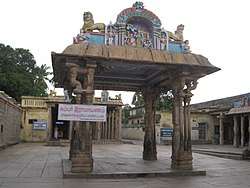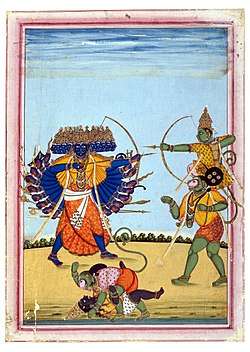Ramavataram
Ramavataram, popularly referred to as Kamba Ramayanam, is a Tamil epic that was written by the Tamil poet Kambar during the 12th century. Based on Valmiki's Ramayana (which is in Sanskrit), the story describes the life of King Rama of Ayodhya. However, Ramavatharam is different from the Sanskrit version in many aspects - both in spiritual concepts and in the specifics of the storyline.[1][2] This historic work is considered by both Tamil scholars and the general public as one of the greatest literary works in Tamil literature.[3]
| Part of a series on |
| Hindu scriptures and texts |
|---|
 |
| Related Hindu texts |
|
Timeline |

Kambar wrote this epic with the patronage of Thiruvennai Nallur Sadayappa Vallal, a Pannai kula chieftain.[4] In gratitude to his patron, Kamban references his name once in every 1,000 verses.
Early references in Tamil literature
Even before Kambar wrote the Ramavataram in Tamil in the 12 Century AD, there are many ancient references to the story of Ramayana, implying that the story was familiar in the Tamil lands even before the Common Era. References to the story can be found in the Sangam literature of Akanaṉūṟu,(dated 400BC)[5] and Purananuru (dated 300 BC),[6][7] the twin epics of Silappatikaram (dated 2nd Century CE)[8] and Manimekalai,[9][10][11] and the Alvar literature of Kulasekhara Alvar, Thirumangai Alvar, Andal and Nammalvar (dated between 5th and 10th Centuries CE).[12]
Structure
The book is divided into six chapters, called Kandam in Tamil. The Kandams are further divided into 123 sections called Padalam (படலம்) in Tamil. These 123 sections contain approximately 12,000 verses of the epic.[13]
Compilation
As with many historic compilations, it was very difficult to discard the interpolations and addendum which have been added over a period of time to the original. This task was taken up a committee of scholars headed by T P Meenakshi Sundaram called the Kamban Kazhagam (Kamban Academy). The compilation published by this committee in 1976 is what is used as the standard today.
Literary significance
Kamban's use of Virutham (Sanskrit: vṛttam) and Santham (Sanskrit: chandas) in various verses is effective in bringing out the emotion and mood for storytelling. He achieves the Virutham and Santham by effective choice of words.
Religious significance
This epic is read by many Hindus during prayers. In some households, the entire epic is read once during the Tamil calendar's month of Aadi (mid-July to mid-August). It is also read in Hindu Temples and other religious associations. On many occasions, Kambar talks about surrendering to Rama, who is a manifestation of Vishnu himself.
The chapter Sundara Kandam is considered very auspicious and is the most popular. The chapter talks about the hardships faced by the main characters in the epic, their practice of restraint, and their hopes for a better tomorrow.
References
- P S Sundaram (3 May 2002). Kamba Ramayana. Penguin Books Limited. pp. 18–. ISBN 978-93-5118-100-2.
- Aiyar, V V S (1950). Kamba Ramayanam - A Study with translations in verse or poetic prose of over four thousand of the original poems. Parliament Street, New Delhi: Delhi Tamil Sangam. Retrieved 18 June 2019.
- "Focus on Kamban, poet extraordinaire". The Hindu. 23 May 2010. Retrieved 8 February 2018.
- Alexander's Lesson and Other Stories. Sura Books. 2006. pp. 44–. ISBN 978-81-7478-807-8.
- Dakshinamurthy, A (July 2015). "Akananuru: Neytal – Poem 70". Akananuru. Retrieved 22 July 2019.
- Hart, George L; Heifetz, Hank (1999). The four hundred songs of war and wisdom : an anthology of poems from classical Tamil : the Puṟanāṉūṟu. Columbia University Press.
- Kalakam, Turaicămip Pillai, ed. (1950). Purananuru. Madras.
- Dikshitar, V R Ramachandra (1939). The Silappadikaram. Madras, British India: Oxford University Press. Retrieved 22 July 2019.
- Pandian, Pichai Pillai (1931). Cattanar's Manimekalai. Madras: Saiva Siddhanta Works. Retrieved 30 July 2019.
- Aiyangar, Rao Bahadur Krishnaswami (1927). Manimekhalai In Its Historical Setting. London: Luzac & Co. Retrieved 30 July 2019.
- Shattan, Merchant-Prince (1989). Daniélou, Alain (ed.). Manimekhalai: The Dancer With the Magic Bowl. New York: New Directions.
- Hooper, John Stirling Morley (1929). Hymns of the Alvars. Calcutta: Oxford University Press. Retrieved 30 July 2019.
- Sujit Mukherjee (1998). A Dictionary of Indian Literature: Beginnings-1850. Orient Blackswan. p. 162. ISBN 978-81-250-1453-9.
- Mudaliyar, V S (1970). Kamba Ramayanam - A condensed version in English verse and prose. New Delhi: Ministry of Education and Youth Services, Government of India. Retrieved 18 June 2019.
- Hart, George L; Heifetz, Hank (1988). The Forest Book of the Ramayana of Kampan. Berkerley, United States: University of California Press. ISBN 9780520060883.

.jpg)